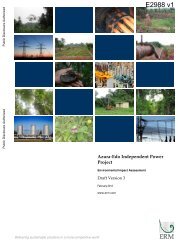Corporate Governance for Banks in Southeast Europe: Policy - IFC
Corporate Governance for Banks in Southeast Europe: Policy - IFC
Corporate Governance for Banks in Southeast Europe: Policy - IFC
Create successful ePaper yourself
Turn your PDF publications into a flip-book with our unique Google optimized e-Paper software.
III. Sound corporate governance pr<strong>in</strong>ciples 11<br />
A. Board practices 12<br />
A well-tra<strong>in</strong>ed, professional, and dedicated board is the most effective means to ensure sound bank<br />
governance. It is also broadly accepted that a professional board can be a key contributor to bank<br />
per<strong>for</strong>mance. As a consequence, most countries <strong>in</strong> the region view the improvement of board practices as a<br />
key policy goal.<br />
Most countries <strong>in</strong> the region have two-tier board structures (a supervisory board and a management board),<br />
with two countries allow<strong>in</strong>g banks to choose and one country (Montenegro) requir<strong>in</strong>g one-tier boards (see<br />
Table 3). In this <strong>Policy</strong> Brief, references to “board” under the two-tier structure are to the supervisory board. 13<br />
Table 3: Board Structures of SEE <strong>Banks</strong> 13<br />
Albania<br />
Bosnia and Herzegov<strong>in</strong>a (Federation)<br />
Bosnia and Herzegov<strong>in</strong>a (Republika Srpska)<br />
Bulgaria<br />
Croatia<br />
FYR Macedonia<br />
Montenegro<br />
Romania<br />
Two-tier<br />
Two-tier<br />
Two-tier<br />
Option to choose one-tier or two-tier<br />
Two-tier<br />
Two-tier<br />
One-tier<br />
Option to choose one-tier or two-tier<br />
Serbia Two-tier 14<br />
Source: Data from EBRD, <strong>Corporate</strong> <strong>Governance</strong> Assessment of <strong>Banks</strong> (2010–2011).<br />
Among domestically owned banks, there may be some<br />
confusion about the different roles of supervisory boards<br />
versus management boards, and supervisory board committees<br />
versus operational committees. In some cases,<br />
bank boards appear to be more directly <strong>in</strong>volved <strong>in</strong> operational<br />
management than best practice would suggest. In<br />
other cases, executives view their operational committees<br />
as fulfill<strong>in</strong>g the same function as (and substitut<strong>in</strong>g <strong>for</strong>) a<br />
committee of the supervisory board. <strong>Banks</strong> need to be<br />
aware of the differences between operational and board<br />
committees, and there may be a need <strong>for</strong> some clarification<br />
<strong>in</strong> law, regulation, and practice. 14<br />
Substance Over Form<br />
“For most countries boards still exist here<br />
purely as a necessary legal requirement<br />
and not as a competitive advantage <strong>for</strong><br />
a company.”<br />
Leonardo Peklar, Slovenia<br />
“Very seldom is the substance discussed over<br />
the <strong>for</strong>m. At the level of the subsidiary <strong>in</strong><br />
unlisted companies, it is only hard law.”<br />
London Conference 2011<br />
11 BCBS, Pr<strong>in</strong>ciples <strong>for</strong> Enhanc<strong>in</strong>g <strong>Corporate</strong> <strong>Governance</strong> (Bank <strong>for</strong> International<br />
Settlements, 2010) (hereafter cited as 2010 BIS Pr<strong>in</strong>ciples), Section III, p. 7.<br />
12 2010 BIS Pr<strong>in</strong>ciples, Section III A, p. 7.<br />
13 EBRD, <strong>Corporate</strong> <strong>Governance</strong> Assessment of <strong>Banks</strong> (2010–2011). A more detailed description of the laws determ<strong>in</strong><strong>in</strong>g board structures can be found<br />
<strong>in</strong> Annex E.1.<br />
14 The Law on Bus<strong>in</strong>ess Entities allows jo<strong>in</strong>t-stock companies to choose between one-tier and two-tier structures. <strong>Banks</strong> are regulated by the Law on<br />
<strong>Banks</strong>, which provides <strong>for</strong> a two-tier governance system.<br />
<strong>Corporate</strong> <strong>Governance</strong> <strong>for</strong> <strong>Banks</strong> <strong>in</strong> <strong>Southeast</strong> <strong>Europe</strong> <strong>Policy</strong> Brief 11

















